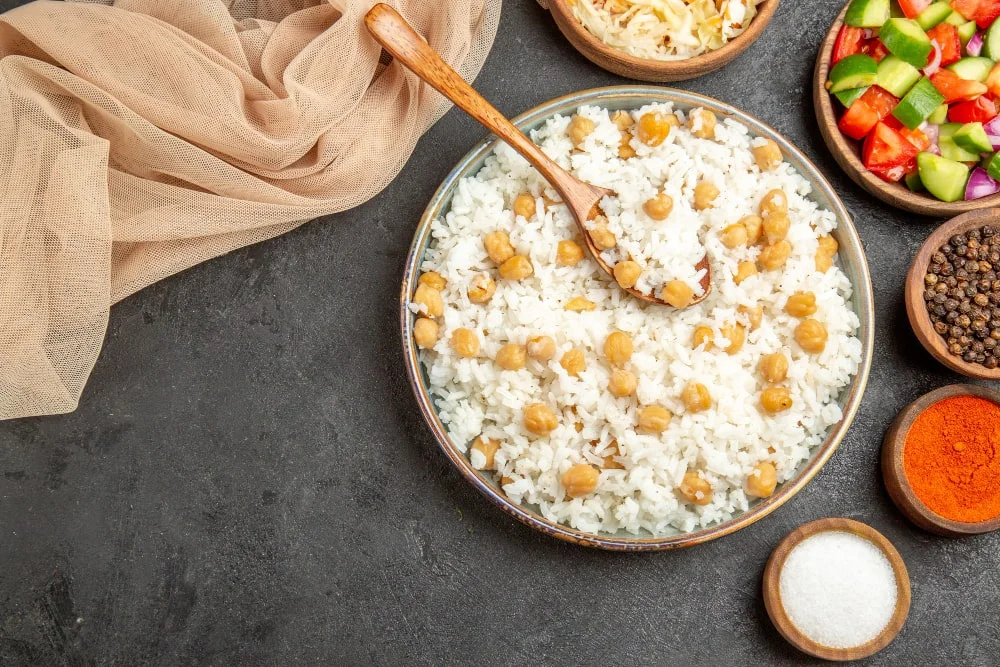Nutritional Values of Rice
Rice is often perceived as a food that must be avoided in the diet, but what matters is the type of rice you consume, portion control, how you cook the rice, and how you consume it. White rice is a type of rice that has been stripped of its bran, and since it has a high glycemic index, it causes sudden fluctuations in blood sugar levels, leading to faster hunger. Since white rice is separated from its bran, it becomes deficient in B vitamins and fiber. If you prefer brown rice instead of white rice, not only does it keep you fuller for longer because of its higher fiber content, but you also get more nutrients, especially B vitamins, compared to white rice.
100 grams of raw white rice contains 79.34 g of carbohydrates, 6.61 g of protein, and 0.58 g of fat. It has no fiber content. On the other hand, 100 grams of raw brown rice contains 74 g of carbohydrates, 7.22 g of protein, and 2.2 g of fat. It contains fiber and is rich in B vitamins.
In a diet, rice consumption should also be considered in terms of food safety. Rice is a risky food in terms of arsenic, a heavy metal harmful to human health. Below, I will provide some tips on how to prepare rice to prevent blood sugar fluctuations and reduce the arsenic content.
- Soak the rice in salty water for a day, then wash it thoroughly until the water runs clear. Starch dissolves in salty water. This way, you'll remove excess starch, resulting in fluffy rice, and reduce the risk of acrylamide (a carcinogenic substance formed during cooking).
- Cook the rice by boiling, not by roasting. This way, there is no risk of acrylamide. Acrylamide is a carcinogenic chemical compound naturally formed during the cooking process of heat-treated foods. Additionally, the glycemic index decreases, meaning it won't spike your blood sugar quickly. It forms resistant starch, turning digestible starch into resistant starch. Thus, it won't raise your blood sugar quickly and keeps you full for longer.
- Consume the rice when it's warm, not hot. This way, the digestible starch turns into resistant starch, preventing rapid blood sugar spikes and keeping you full for longer.
- The biggest risk in rice is ARSENIC, a heavy metal. It is possible to minimize arsenic content using the parboiling method. This method has been proven to significantly reduce arsenic and preserve vitamin and mineral values. Parboiling method: Use a 1:4 ratio of rice to water. That is, for 1 cup of rice, use 4 cups of water and boil for a few minutes. Then, drain the water and add the half-cooked rice back into the pot, adding boiling water. The method suggests using 2 cups of boiling water for 1 cup of rice, but this ratio may vary depending on the rice type. I recommend adding water gradually. Start with 1 cup, and if the rice is still undercooked after absorbing the water, add a little more to avoid making it mushy. Once cooked, you can add salt and, if desired, butter or another type of fat.
- By adding vegetables or legumes such as green lentils or chickpeas to your rice, you can obtain a more balanced meal with controlled blood sugar levels. Examples include rice with artichokes, onions, parsley, peas, green lentils, mung beans, or chickpeas.
- The choice of rice is very important. You can prefer basmati rice with a low glycemic index, black rice, brown rice, or Karacadağ rice, which I prefer because it is nourished by groundwater and thus has a lower arsenic risk.
Even if we do all these, it is always necessary to consume rice with portion control.
RD. Asena PERÇİN BAHADIR
Functional Medicine Dietitian


